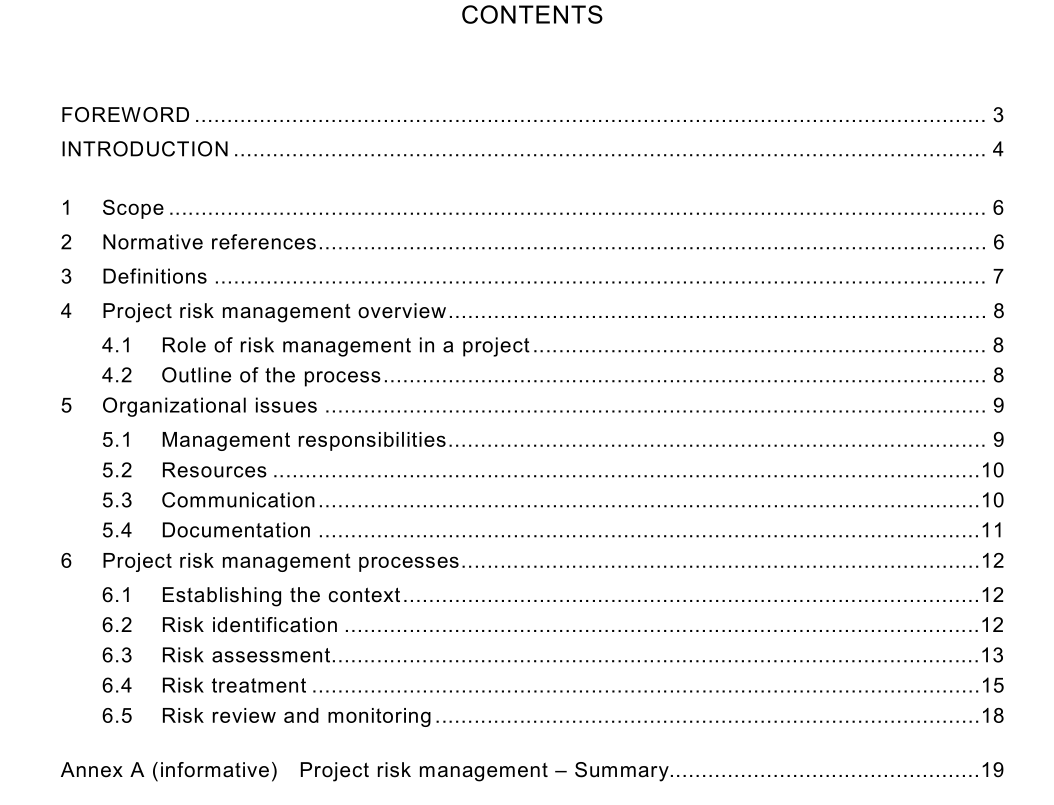BS IEC-62198 pdf download

BS IEC-62198 pdf download.Project risk management – Application guidelines
1 Scope
This International Standard is applicable to any project with a technological content. It may also apply to other projects. It provides a general introduction to project risk management, its subprocesses and influencing factors. These subprocesses are: – establishing the context, including confirmation of project objectives; – risk identification; – risk assessment, including risk analysis and evaluation; – risk treatment; – review and monitoring; – communication (including consultation); – learning from the project. Guidelines are provided on the organizational requirements for implementing the process of risk management appropriate to the various phases of a project. It is recognized that, in certain circumstances, it may be inappropriate to include all the clauses of this standard within a contract. Accordingly, this standard should only be considered as forming part of a contract – however that contract may be formed – if the parties to that contract explicitly call upon and refer to this standard (or parts thereof) and require it to be included within the contract.
3 Definitions
For the purposes of this International Standard, the terms and definitions of IEC 60050(191) apply, together with the following. 3.1 product results of an activity or process which may include service, hardware, processed materials, software or a combination thereof 3.2 project unique process, consisting of a set of coordinated and controlled activities with start and finish dates, undertaken to achieve an objective conforming to specific requirements, including the constraints of time, cost and resources NOTE 1 An individual project may form part of a larger project structure. NOTE 2 In some projects, the objective(s) is (are) refined and the product characteristics defined progressively as the project proceeds. [ISO 10006] 3.3 process set of inter-related resources and activities which transform inputs into outputs [ISO 10006] 3.4 project risk combination of the probability of an event occurring and its consequences for project objectives 3.5 risk management systematic application of management policies, procedures and practices to the tasks of establishing the context, identifying, analysing, evaluating, treating, monitoring and communicating risk 3.6 risk treatment process of selection and implementation of measures to modify risk NOTE 1 The term “risk treatment” is sometimes used for measures themselves. NOTE 2 Risk treatment measures may include avoiding, optimizing, transferring or retaining risk.
4 Project risk management overview
4.1 Role of risk management in a project Risk is associated with every project and with each process and each decision throughout the life of a project. Risk should therefore be managed at each stage of the project and the risk management process should be integrated with both the project management processes and the product-related processes. Everyone is involved in risk management. A structured process of risk management is required in order to facilitate open communication and cost- effective management of risks. A prerequisite of effective project risk management is frank and open communication both inside and outside the project. 4.2 Outline of the process The project risk management process starts by establishing the context in which the project is undertaken. This includes identifying the interested parties, understanding the objectives and outputs of the project and defining the scope and boundaries of the risk management activity for a particular project. The interface to, and overlap with, any other projects and the organizational and strategic constraints within which the project operates, should be defined. The next step in the risk management process is risk identification. This task is fundamental to the risk management process. Each identified risk should be subjected to subsequent project risk management activities of risk assessment, risk treatment and review and monitoring. The process may be applied first at a broad level to identify general risk issues, then at a more detailed level to look at particular risks and how they might arise. Risks should be managed at each phase of the project and risks to the project itself and to its product should be reviewed. The concept of the project risk management process is illustrated in figure 2.









